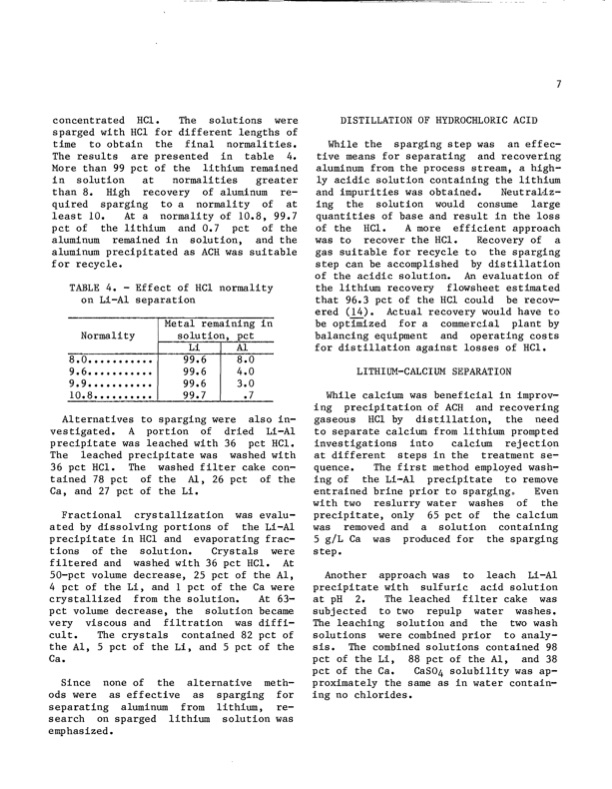
PDF Publication Title:
Text from PDF Page: 012
concentrated HCI. The solutions were sparged with HCI for different lengths of time to obtain the final normalities. The results are presented in table 4. More than 99 pct of the lithium remained aluminum from the process stream, a high- in solution at normalities greater ly acidic solution containing the lithium than 8. High recovery of aluminum re- and impurities was obtained. Neutra~iz quired sparging to a normality of at least 10. At a normality of 10.8, 99.7 pct of the lithium and 0.7 pct of the aluminum remained in solution, and the aluminum precipitated as ACH was suitable for recycle. TABLE 4. - Effect of HCI normality on Li-AI separation ing the solution would consume large quantities of base and result in the loss of the HCI. A more efficient approach was to recover the HCI. Recovery of a gas suitable for recycle to the sparging step can be accomplished by distillation of the acidic solution. An evaluation of the lithium recovery flowsheet estimated that 96.3 pct of the HCI could be recov- ered (14). Actual recovery would have to be optimized for a commercial plant by balancing equipment and operating costs for distillation against losses of HCI. LITHIUM-CALCIUM SEPARATION Normality 8.0........... 9.6........... 9.9........... 10.8.......... Metal remaining in solution, pct Li AI 99.6 8.0 99.6 4.0 99.6 3.0 99.7 .7 While calcium was beneficial in improv- ing precipitation of ACH and recovering Alternatives to sparging were also in- gaseous HCI by distillation, the need vestigated. A portion of dried Li-AI to separate calcium from lithium prompted precipitate was leached with 36 pct HCI. investigations into calcium rejection The leached precipitate was washed with at different steps in the treatment se- 36 pct HCI. The washed filter cake con- quence. The first method employed wash- tained 78 pct of the AI, 26 pct of the ing of the Li-AI precipitate to remove Ca, and 27 pct of the Li. entrained brine prior to sparging. Even with two reslurry water washes of the Fractional crystallization was evalu- precipitate, only 65 pct of the calcium ated by dissolving portions of the Li-Al was removed and a solution containing precipitate in HCI and evaporating frac- 5 giL Ca was produced for the sparging tions of the solution. Crystals were step. filtered and washed with 36 pct HCI. At 50-pct volume decrease, 25 pct of the AI, 4 pct of the Li, and 1 pct of the Ca were crystallized from the solution. At 63- pct volume decrease, the solution became very viscous and filtration was diffi- cult. The crystals contained 82 pct of the AI, 5 pct of the Li, and 5 pct of the sis. The combined solutions contained 98 Ca. pctoftheLi, 88pctoftheAI, and38 pct of the Ca. CaS04 solubility was ap- Since none of the alternative meth- proximately the same as in water contain- ods were as effective as sparging for ing no chlorides. separating aluminum from lithium, re- search on sparged lithium solution was emphasized. DISTILLATION OF HYDROCHLORIC ACID While the sparging step was an effec- tive means for separating and recovering Another approach was to leach Li-AI precipitate with sulfuric acid solution at pH 2. The leached filter cake was subjected to two repulp water washes. The leaching solution and the two wash solutions were combined prior to analy- 7PDF Image | Recovering Lithium Chloride From a Geothermal Brine 1984

PDF Search Title:
Recovering Lithium Chloride From a Geothermal Brine 1984Original File Name Searched:
cdc_10654_DS1.pdfDIY PDF Search: Google It | Yahoo | Bing
Product and Development Focus for Infinity Turbine
ORC Waste Heat Turbine and ORC System Build Plans: All turbine plans are $10,000 each. This allows you to build a system and then consider licensing for production after you have completed and tested a unit.Redox Flow Battery Technology: With the advent of the new USA tax credits for producing and selling batteries ($35/kW) we are focussing on a simple flow battery using shipping containers as the modular electrolyte storage units with tax credits up to $140,000 per system. Our main focus is on the salt battery. This battery can be used for both thermal and electrical storage applications. We call it the Cogeneration Battery or Cogen Battery. One project is converting salt (brine) based water conditioners to simultaneously produce power. In addition, there are many opportunities to extract Lithium from brine (salt lakes, groundwater, and producer water).Salt water or brine are huge sources for lithium. Most of the worlds lithium is acquired from a brine source. It's even in seawater in a low concentration. Brine is also a byproduct of huge powerplants, which can now use that as an electrolyte and a huge flow battery (which allows storage at the source).We welcome any business and equipment inquiries, as well as licensing our turbines for manufacturing.| CONTACT TEL: 608-238-6001 Email: greg@infinityturbine.com | RSS | AMP |